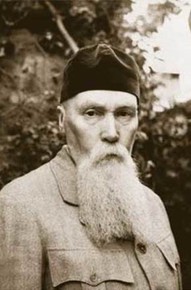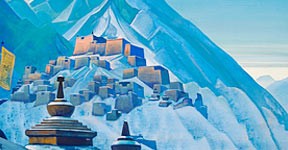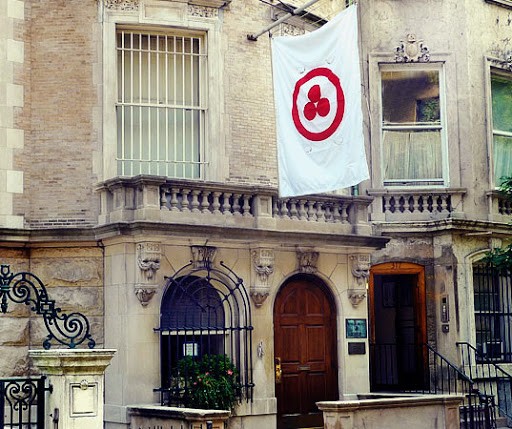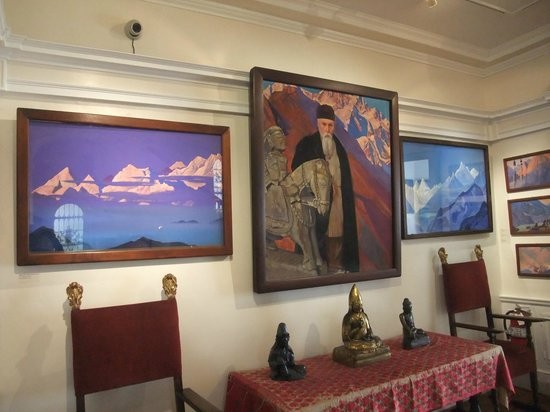Nicholas Roerich Museum
Introduction
Text-to-speech Audio
Images
Portrait of Nicholas Roerich.

Roerich's painting, "Tibet, Himalayas."

Facade of the Nicholas Roerich Museum. The flag flying above the door is Roerich's Banner of Peace flag that accompanies the Roerich Pact.

Interior view of the musuem.

Backstory and Context
Text-to-speech Audio
Nicholas Roerich was born in St. Petersburg, Russia on October 9, 1874. Thanks to his middle-class upbringing, Roerich was exposed to a variety of intellectual pursuits and developed an avid interest in the world around him. At the age of 16, Roerich expressed interest in attending the Academy of Art, though his father objected and insisted that his son study law. The two struck a compromise and in fall 1893, Roerich enrolled in both the Academy of Art and St. Petersburg University. During his time in school, Roerich’s appreciation for the arts blossomed; he attended avant-garde musical performances, edited the World of Art magazine, and experimented with painting techniques. Just after graduating and just before embarking on a year-long tour of the European art world, Roerich met Helena Shaposhnikov, daughter of an architect and niece of the composer Mussorgsky. The two quickly became engaged, before being married upon Roerich’s return from western Europe. The attraction between the two was no mystery. Like the multi-faceted Nicholas, Helena was an accomplished pianist, writer, and intellectual thinker.
Understanding the necessity of a salary, Nicholas Roerich applied for and received a position as Secretary of the School of the Society for the Encouragement of Art. Committed to fundamentally changing the way the organization operated, Roerich quickly rose to the position of head. Under his leadership, the society incorporated a broad artistic curriculum which incorporated studio arts, theater, and music. In 1902, the Roerich’s first son, George, was born. Shortly after this, the Roerich family toured around Russia, researching historical architecture and sites. Seeing the decrepit and neglected monuments had a profound impact upon Nicholas Roerich. He continued collecting artifacts and antiquities from ancient civilizations, as much to save them as to have them for his own study.
In 1906, Roerich’s national horizons were broadening. Sergei Diaghilev, an advocate for all forms of Russian art, organized a Parisian exhibition of Russian paintings, and included sixteen of Roerich’s works. Over the next few years, in large part due to Diaghilev’s efforts, demand for Russian theater in western Europe continued to grow. Roerich was involved satiating this demand via his roles designing costumes and sets for Russia’s most avant-garde early twentieth century composers. Perhaps most famously, it was Roerich’s costumes that performers wore in the revolutionary 1913 debut of Igor Stravinsky’s Rite of Spring, which left audiences unequivocally stunned. As the 1910s wore on and the political climate of Europe began to turn sour, the Roerich family spent time in Finland, where Nicholas painted the landscape extensively. He also wrote several books of poetry, which enjoyed moderate success in the United Kingdom.
In 1920, Roerich accepted an invitation from the Chicago Art Institute to exhibit his work. After the show, the artist found himself drawn to America’s entrepreneurial spirit and sublime landscapes. He moved to New York, where he founded the Master Institute of United Arts, an echo of his earlier work with the School of the Society for the Encouragement of Art. The institute flourished and its interdisciplinary approach was wildly popular. However, the Roerichs’ stay in America was relatively brief and by 1923, the opportunity to visit India presented itself. For many years, the couple toured India, China, and Nepal, before eventually settling in the Himalayan Kullu Valley in 1928. Though they continued to travel frequently, the Roerichs spent most of the rest of their life in Asia.
On April 15, 1935, Nicholas Roerich managed to accomplish a major life goal. It was on this date that the Pan-American Union – which included the United States and most Latin American countries – signed the Treaty on the Protection of Artistic and Scientific Institutions and Historic Monuments, better known as the Roerich Pact. This convention aims to protect cultural heritage in times of war and peace by granting them the same status as a field medic or humanitarian organization. Sites under the protection of the pact are encouraged to fly a flag designed by Roerich and called the Banner of Peace. The Roerich Pact has spawned a movement known as Pax Cultura, which advocates for a globally shared culture. The treaty was so instrumental in laying the groundwork for the protection of heritage sites, that the 1954 Hague Convention specifies that the Hague Convention does not replace the Roerich Pact, and is only supplementary to it.
Nicholas Roerich died in 1947 in Kullu Valley, with Helena following a few years after in 1955. In addition to the Roerich Pact, Nicholas Roerich’s legacy lives on in a variety of ways. Though the Master Institute of United Arts did not survive the Great Recession, it was reborn as the Nicholas Roerich Museum in 1949. The museum initially occupied the same building as the Master Institute, though it moved to a more modest brownstone at a later point. Still occupying the brownstone today, the Roerich Museum is almost better described as a cultural center than a museum. The organization possesses over two hundred paintings by the artist, awards an annual prize for poetry, provides a music venue, and makes recordings of Roerich’s music and lectures available to the public. The museum receives around six thousand visitors a year interested in learning more about the fascinating life and ideals of Nicholas Roerich.
Sources
About the Museum. Nicholas Roerich Museum New York. Accessed October 15,2020. http://www.roerich.org/museum-about.php.
Nicholas Roerich Museum, NYC Arts. Accessed October 15th 2020. https://www.nyc-arts.org/organizations/158/nicholas-roerich-museum.
Nicholas Roerich (1874-1947), Nicholas Roerich Museum New York. Accessed October 15th 2020. http://www.roerich.org/roerich-biography.php.
Roerich Pact Treaty on the Protection of Artistic and Scientific Institutions and Historic Monuments, U.S. Committee of the Blue Shield. Accessed October 15th 2020. https://uscbs.org/1935-roerich-pact.html.
Varoli, John. Mysterious Russian artist Nicholas Roerich's New York 'headquarters', Russia Beyond. February 20th 2020. Accessed October 15th 2020. https://www.rbth.com/arts/331722-nicholas-roerich-new-york-museum.
International Roerich Memorial Trust. Accessed October 15, 2020. http://irmtkullu.com/the-roerich-family/nicholas-roerich/.
Roerich, Nicholas. "Tibet, Himalayas." 1933. Nicholas Roerich Museum. Accessed October 15, 2020. http://www.roerich.org/museum-about.php.
Nicholas Roerich Museum. Accessed October 15, 2020. http://www.roerich.org/museum-about.php.
TripAdvisor. Accessed October 15, 2020. https://www.tripadvisor.com/Attraction_Review-g60763-d136141-Reviews-Nicholas_Roerich_Museum-New_York_City_New_York.html.
